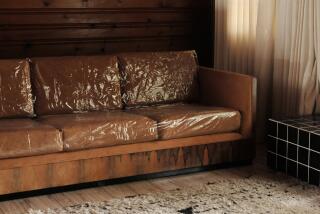There’s a lot of fluff to these relationships
What treasure would you save if a natural disaster strikes?
The key to a lifetime of sound sleep, says one Atlanta attorney. “If there’s a fire, what am I going in there for? I’ve thought about that,” says Asim Raza. “Kids and wife. And then -- my pillow. If you’re 35 and you’ve been sleeping on the same pillow for 31 years, you don’t take that lightly.”
This isn’t a joke to Raza, or to the many other adults who are deeply attached to the cushions that lull them to sleep each night. Before getting married, Raza told his fiancee, “My pillow is really important to me.” She laughed, so Raza reiterated: “No, I’m not kidding. This is really important.” Despite the occasional joke about security blankets, “she has actually been very respectful of it,” he says. “She knows what I’m like without it.”
Like most people interviewed for this story, Raza isn’t anxious to discuss his pillow on the record -- “Don’t make me look like a fool,” he pleads -- but pillow attachment isn’t anything to feel sheepish about, says Carmel Valley psychologist Lee Jampolsky.
“Ironically, people aren’t embarrassed about carrying 12 cellphones, but are embarrassed if they have some kind of relationship with their pillow,” she says. “It’s very common, and at the core it’s very healthy. Mine happens to have a name: Pillow.”
While Raza refuses to reveal its name, he will chat about his pillow’s history. His parents gave him the thin cotton pillow when he was 4 1/2, and it has remained nearby ever since. It hasn’t been easy: “As a kid, my brother would steal the pillow and then say, ‘Either you do the vacuuming today or you’re not getting the pillow back,’ ” Raza says. You can guess who did the vacuuming.
While attending American University in Washington, D.C., Raza enlisted his roommate to help protect his pillow. Both his mother and his grandmother have made covers for it. “I’ve got to get buried with this thing,” he says. “But I’m a Muslim, and you’re not supposed to take anything with you. I’ll probably leave it as a family heirloom.”
These generic teddy bears provide comfort and company much the way a special blanket may have soothed many of these same adults when they were young. It’s a dependent and healthy relationship, experts say, that stretches beyond the human world. A beloved pillow can stand in for, or even come to represent, the feeling of connectedness that all primates require, says USC anthropology professor Craig Stanford.
“Even chimps in the L.A. Zoo ... are very fond of the bedding they’re given,” he says. “They don’t drag around pillows, but they do drag around their sleeping materials sometimes.”
“Pilly” goes with Debra Kent wherever the 46-year-old publicist from Bloomington, Ind., travels. “I’ve never felt this way about anything,” says Kent of her 6-year-old feather pillow. “I didn’t have any attachment objects when I was a kid. No pacifier or anything. But this pillow, it just means home to me.” On road trips, Kent keeps it in the car. “My kids bring their pillow and blankets,” she says. “Why shouldn’t I bring mine too?”
Kent’s friend, animal control officer Vicki Minder, can’t make fun of her -- after all, Minder sleeps with her own 24-year-old pillow, named “Pink.”
Adults who still sleep on their childhood pillows say they imbue bedtime with the same kind of warmth and safety they felt when Mom and Dad used to kiss them goodnight and tuck them in. As Raza puts it, “Harmony, music and warm milk all combine into a pillow.... The smell of my pillow just immediately relaxes me ... the same smell since I was 4 1/2 years old.”
Chicago philanthropist Kathy Posner can’t sleep or watch TV without cradling her 44-year-old “Happy Pillow.” She cried into the pillow when she was 16 and her father died, and she embraced it six years later when her mother passed away. She carried it to college and to wherever she moved since. She totes it on trips when she can fit it in her luggage.
Posner has a recurring nightmare: She’s a teenager, sitting in her family’s living room, when the phone rings and her mother screams -- and Posner learns for the umpteenth time that her father is dead of a heart attack. After she is startled awake, she hugs Happy Pillow. It is her salve. When she was a girl, it was “something I could hold onto,” she says. “That’s still the case.”
Pillow attachment “is something I encounter quite a bit with my clients,” says Los Angeles therapist Yvonne Thomas -- and it’s a healthy alternative to addictions and vices, she says.
“There are so many ways a person can comfort themselves. They can smoke, gamble, have sex indiscriminately,” Thomas says. “Let this be the way a person copes. Instead of drinking, instead of overeating, let them reach for their pillow when they’re sad and stressed.”
Chiropractors and allergists tend to disagree.
A pillow should be a tool to keep yourself in correct alignment as you sleep, says Jerome F. McAndrews, spokesman for the American Chiropractic Assn. -- and broken-down cushions don’t provide the level of support that your head and neck require. “If you get in the habit of sleeping.... with an old pillow that gives no support, you’re going to encourage disk and joint degeneration,” he says.
Then there’s the ick factor.
An old pillow may well be “one of the dirtiest places in the home,” says Jonathan Corren, medical research director of the Allergy Research Foundation in Los Angeles. Pillows that aren’t regularly cleaned and protected, he says, can become a repository for dust mites, dirt, volatile organic compounds such as wood finishes, pet dander, even mold.
If you have allergies or asthma, Corren recommends that you either toss the ancient pillow or use one of the many hypoallergenic casings available. Or leave it in the freezer overnight to rid it of dust mites, says Glen Needham, associate professor of entomology at Ohio State University.
Many of the pillow-obsessed say they sheathe their sleeping aids in miteproof covers. But Raza says he would never trade his pancake-thin pillow for an orthopedic one, even if it meant assuaging the back pain that has long pestered him. “What I would gain in lack of back pain, I would lose walking around with bags under my eyes,” he says.
Kim Garretson’s pillow became “an anchor” when he faced down illness and made life changes. The 54-year-old marketing director from Minneapolis says he was “consumed with work” for much of his adulthood. Then in 2001 a diagnosis of advanced prostate cancer shook him. After undergoing surgery -- with a “surprisingly good outcome” -- Garretson retreated to a cabin in northern Minnesota for a long November weekend, taking with him his dog and his then 6-year-old pillow.
When he emerged, he abandoned his career as an entrepreneur and opted for a corporate gig that allows him to spend more time with his family. His foam pillow, now 10 years old and going strong, remains with him.
*
(BEGIN TEXT OF INFOBOX)
A guide to pillow talk
How do you know when it’s time to trade in that old pillow? Some tips on when to let go and what to look for in something new:
Test it out
To find out if it’s time to replace your pillow, try this:
Lay pillow on a flat, hard surface, fold it in half and squeeze out the air. Then release it. If the pillow unfolds and springs back into its original shape, it has some life left in it. If it remains folded, it’s time to throw it out.
Use your head
When choosing a new pillow, put as much time and thought into it as you would a mattress.
“Take the time to lie down with it in the store,” says Jerome F. McAndrews, spokesman for the American Chiropractic Assn. “Your head should not be propped up, and it should not be slumped. You want to keep your spine and neck straight.”
There are three basic types:
* Firm pillows are best for side sleepers because they’re strong enough to fill the gap between the top of the mattress and your shoulders.
* Medium-density pillows provide the best support when sleeping on your back because they cradle your head while supporting your neck.
* Soft pillows are best for people who sleep on their stomachs or change positions frequently.
When in doubt, err on the side of softness, says McAndrews. “You can always get a floppy pillow and crunch it up to where you are comfortable.”


